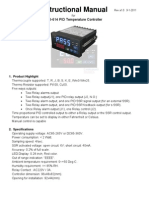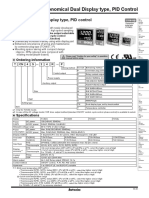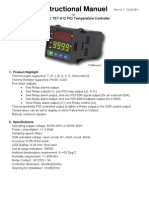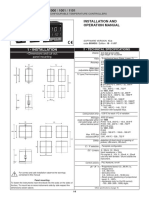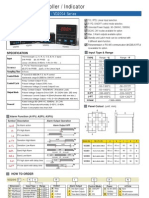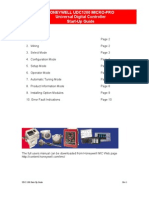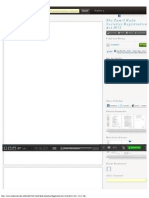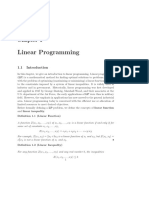Uputstvo PMG
Uputstvo PMG
Uploaded by
Zoka MarinkovićCopyright:
Available Formats
Uputstvo PMG
Uputstvo PMG
Uploaded by
Zoka MarinkovićOriginal Title
Copyright
Available Formats
Share this document
Did you find this document useful?
Is this content inappropriate?
Copyright:
Available Formats
Uputstvo PMG
Uputstvo PMG
Uploaded by
Zoka MarinkovićCopyright:
Available Formats
1 Users Manual
1 Warranty Sheet
1 Declaration of Conformity
1 Fixing bracket, 2 screws
2.3 FRONT PANEL
Thank you for choosing a NIVELCO instrument.
We are sure that you will be satisfied throughout its use.
1. APPLICATION
The UNICONT PMG-411, PMG-412 and PMG-413 universal analogue PID-controllers can be used with a
Pt-100 resistance thermometer and with different thermocouples for temperature measurement, control as
well as processing the signals of transmitters with 4 20 mA and 15 V DC or 010 V DC output. The
output signal of the controller can be a relay, continuos 4 20 mA process current signal or SSR-driver.
Additional alarm relay provides for limit monitoring. The unit is microprocessor based, has an auto-tuning
software, automatic and its PID controller able to find the optimum of the P-I-D constants. The setting can be
performed by the keyboard on the front side. The large bi-coloured display provides easy reading even from
far distance. The process parameters are red, the set values are green.
2. TECHNICAL DATA
TYPE PMG-411-; -412; -413-
Resistance
thermometer
(3 cable, aut. cable
compensation)
DIN Pt 100 (199.9 C...+199.9 C or 0 C...+500 C)
R cable: max. 5 Ohm
K (-100 C+1100 C); J (0 C+800 C)
R (0 C+1700 C); E (0 C+800 C)
T (-200 C+400 C); S (0C+1700 C)
Thermocouple
(aut. cold junction
compensator)
N (0 C+1300 C); W (0 C+2300 C)
Voltage 15 V DC; 010 V DC
Input
Current 420 mA DC / 250 Ohm
Proportional range (P) 0100%
Integral time (I) 03600 s
Derivative time (D) 03600 s
PID (auto-tuning)
Cycle time (C) 1120 s
Relay SPDT; 250 V AC, 3 A, AC1
SSR driver 12 V DC 3 V, max. 30 mA
Control output
Output
Current 420 mA DC (max. load 600 Ohm)
Alarm output SPST programmable relay, 250 V AC, 1 A, AC1
Setting and display accuracy 0,3 % 1 digit for the whole input scale or 3 C
PV (process variable) 4 digit, 7 segment 11 mm high red LED
Display
SV (set value) 4 digit, 7 segment 7 mm high green LED
Power supply 90264 V AC 50/60 Hz, max. 5 VA
Protection Front side: IP 65, Back side: IP 20
Electronic protection Class II Reinforced Isolation
Ambient temperature Operational: -10+50 C, Storing: -20+60 C
Ambient humidity 35 85% RH
Dimensions 48 x 48 x 107 mm (panel cut out: 45.5
+0,5
x 45.5
+0,5
mm)
Weight 0.15 kg
USERS MANUAL
Manufacturer:
NIVELCO Process Electronics Co.
1043 Budapest, Dugonics u. 11.
Phone: 36-1 369-7575 Fax: 36-1 369-8585
e-mail: sales@nivelco.com www.nivelco.com
2.1. ACCESSORIES 2.2. ORDER CODE
UNICONT P M G - 4 - 1
Input Code Output Code
1 Universal input 1 2 relays 1
SSR driver 2
420 mA 3
1
PV: Process value display (red)
6
: Display setting keys
2
SV: Set value display (green)
7
EV1: Indicates the alarm output
8
OUT: Indicates the output
3
SV2: If this LED is ON, the second, internal set
point is effective.
4
AT LED: Flashing during auto tuning
9
P/E key: Enters/ escapes programming
5 6
8
7
1
2
3
4
9
5
AT key: auto tuning operation
3. DIMENSIONS Minimal distances on the front side
min 55
min 62
Fixing bracket
P/E
Selecting
sensor
Alarm
mode
Alarm
latch
PID
control
mode
Cooling or
heating
mode
Upper
measurement
limit
Measurement
unit
Programming
access lock
Selecting
sensor
P/E P/E P/E P/E P/E P/E P/E P/E
Lower
measurement
limit
4. WIRING
US : Power Supply
OUT : Control Output
IN1 : Sensor Input
AL1 : Alarm Output
IN2 : Processor Input
12
11
AL1
5
4
3
2
1
U
S
OUT
10
9
8
7
6
-
+
IN1
Pt 100
TC
12
11
AL1
5
4
3
2
1
US
SSR
10
9
8
7
6
-
+
IN1
Pt 100
TC
OUT
-
+
12
11
AL1
5
4
3
2
1
U
S
4...20 mA
10
9
8
7
6
-
+
IN1
Pt 100
TC
OUT
-
+
PMG-411 PMG-412 PMG-413
5. PROGRAMMING
Program menu can be entered by long and simultaneous pressing of the P/E and keys (t > 3 s)
If no key is pressed within 20 s, factory setting (DEFAULT) will be returned.
PROGRAM MENU
Input
Alarm mode
Alarm latch
PID control algorithm
Cooling or heating control
Engineering unit of the temperature measurement unit
Upper measurement limit
Lower measurement limit
Programming access lock
SETTING THE CONTROL PARAMETERS Control parameters can be entered by pressing key
P/E longer than 3 s
Setting second (internal) set point. Effective with the short circuit of input IN2
Setting operation value of the alarm relay (if operation selected in EV-1 menu)
Setting delay of the loop break indication relay output (0 999 s)
(if operation selected in EV-1)
Setting proportional band from 0 % to 100 %
Setting integral time from 0 to 3600 s
Setting derivative time from 0 to 3600 s
Setting cycle time of the control relay from 1 to 120 s
Setting switching difference from 0 to 100C for ON/OFF control
Modifying the measured value between -49 and +50 C.
Also applicable with calibration (OFFSET function)
Setting proportional control range from 0 to 100 % (for control only)
Setting rising gradient for RAMP mode if heating (settable range of time to reach the SV: 1 to 99 min)
Setting rising gradient for RAMP mode if cooling (settable range of time to reach the SV: 1 to 99 min)
Access lock
ON OFF
If the access lock is active no parameter can be entered
CHANGING THE SET POINT
Pressing key set value will be flashing
Using key the required parameter value can be set
Pressing key again the next parametern will be reached
Confirm settings with the key P/E.
SETTING THE ON/OFF CONTROL
Set the PID parameters to zero
The HIS code will be displayed.
The switching difference can be set in this menu if needed.
Measurement range : 0100 C or
010.0 C, depending on the decimal point
SELECT INPUT WITH MEASUREMENT RANGE
DISPLAY INPUT RANGE REMARKS
YCA.H
K thermocouple -100+1300 C
YCA.L
K thermocouple -100+999 C Reduced
jic.h
J thermocouple 0+800 C
jic.l
J thermocouple 0.0+800.0 C Decimal point
R thermocouple 0+1700 C
E thermocouple 0+800 C
E thermocouple 0.0+800.0 C Decimal point
T thermocouple -800+400 C
T thermocouple -199.9+400.0C Decimal point
S thermocouple 0+1700 C
N thermocouple 0+1300 C
W thermocouple 0+2300 C
J: Pt 100 0+500 C
J: Pt 100 -199.9+199.9C Decimal point
DIN Pt 100 0+500 C
DIN Pt 100 -199.9+199.9C Decimal point
0 10 V DC -199.9 +9999
1 5 V DC -199.9 +9999
4 20 mA -199.9 +9999
Jumper setting
and scaling are
needed
ALARM EVENTS
Only the alarm event can be indicated on the display, which has been selected in
menu Alarm Events.
Current loop break
Sensor break
Alarm relay failure
SV
AL-1
h
PV exceeding the relative
upper limit value.
PV>SV+ AL1
SV
h
AL-1
PV exceeding the relative
lower limit value.
PV<SV- AL1
SV
h h
AL-1 AL-1
PV is outside the range of
the SV
SV
h h
AL-1 AL-1
PV is within the range of
the SV
SV AL-1
h PV exceeding the
absolute upper limit value.
PV>AL1
SV
h
AL-1
PV exceeding the
absolute lower limit value
PV<AL1
Remark: h = 2 C switching difference is fixed.
ALARM RELAY DISABLING
MODE OPERATION DESCRIPTION
Standard No latch
Latch
Remains latched after triggering.
Release by selecting AL-A.
Standby Latch
No triggering at first reaching of PV
SV. The output does not switch on if
the PV first reaches the set point (SV).
It triggers only if PV differs from the
SV and reaches the alarm value.
Latch and Standby
Simultaneous use of latching and
standby order.
SETTING THE ANALOGUE INPUT
Pushing both fasteners on the back side, the instrument can be pulled out of the
box. There are two jumpers (S/W1 and S/W2) inside the instrument. The jumpers
can be carefully pushed off and pulled back according to the figure below.
A.) Resistance thermometer and thermocouple input
B.) Voltage input (1 ... 5 V DC, 0 ... 10 V DC)
C.) Current input (4 ... 20 mA)
SV-2 OPERATION (INTERNAL SET POINT)
The SV can be seen on the lower green display and set by the keys on the front
panel.
There is a possibility to set a second internal SV in the SV-2 menu, which is
effective with the short circuit of the input points IN2.
MEASURED VALUE OFFSET (PARAMETER In-b)
Displayed value can be shifted with any value in the parameter In-b menu (Offset
Function). This can be applied for instance for cable compensation with
temperature measurement of two wire Pt 100.
SCALING
Measurement range will automatically be determined with the use of Pt 100 or
thermocouple. For analogue inputs (420 mA, 010 V DC, 15 V DC) the low
and the high values have to be entered in menu L-SC (low value) or
H-SC (high value).
SETTING RISING TEMPERATURE GRADIENT (RAMP)
The required delay can be set in the rAPU menu for heating and in rAPd for
cooling is needed. After reaching the new SV, will be kept by the controller.
6. CONTROL ALGORITHM
There are three different control algorithms, which can be set by the UNICONT
PMG-411, -412 unit.
ON / OFF control
Proportional (P) control
PID control
The best accuracy can be achieved by PID control. The PMG-413 unit with
analogue output can only be used as PID controller.
It is essential to define the control characteristic: whether heating or cooling is
needed.
COOLING/HEATING CONTROL
The unit is able to control the cooling/heating process and it can also be used for
level control. The filling control corresponds with the heating algorithm and the
emptying control with the cooling algorithm.
The algorithm can be selected in menu o-Ft.
Select HEAT: heating or filling control
Select CooL: cooling or emptying control
t
PV
Y
t
PV
Y
Cooling/emptying Heating/filling
PV = process variable Y = control signal
ON / OFF CONTROL
Setting the PID parameters to zero the unit can be operating as an ON/OFF
controller.
In this case the controller offers a settable symmetrical switching difference in the
menu HIS.
The heating or cooling algorithm should be set (see menu o-Ft)
PROPORTIONAL (P) CONTROL
In case of proportional control the value of gain (P) is other than zero but the
integral and derivative times are zero. The proportional gain can be set between
1100%. Control will be accomplished by changing the time of the relayss
energised and de-energised state within the its cycle time. The cycle time of the
relay can be set in the menu T between 1120 s.
Proportional band: the control range of the cycle. Out of the proportional band
the relay is always energised or de-energised.
The proportional baude: q = P (%) M
where M = measurement range.
The location of the proportional band compared to the SV depends on the
percentage value in the menu rESt. If rESt value = 0%, the whole range is under
the SV.
If rESt value = 0 %, the whole band is under the SV.
If rESt value = 50.0 %, the proportional band is symmetrically situated to
the SV
If rESt value = 100 %, the proportional band is situated over the SV
SV
q
rESt = 0%
R
SV q
rESt = 50,0%
R
Relay operation depending on rEST percentage by proportional control
PID CONTROL
The PID control is the most commonly used control mode. Similar to the
proportional control PID control will be accomplished by changing the relays
energised and de-energised states within its cycle time. Since determination of
the PID parameters by the manual trial and error method the use of the AT mode
is suggested.
AT MODE
Sensing characteristic features of the control process, the unit determines
automatically the PID parameters and the cycle time.
AT mode will be started by pressing key AT at least 3 s.
During the auto tuning the AT-LED will be blinking and it will turn off if completed.
Auto tuning can be interrupted by pressing key AT for longer than 3 sec. Auto
tuning procedure is suggested to repeat from time to time since thermal features
may be changed.
PID RAMPING MODES
There are two different ramping modes
With the first one, the PV reaches the SV with high speed. In this case a minor
override will occur (Fig. 1.), by the second one the PV reaches the SV slower
but without override (Fig. 2.)
Selecting and setting can be performed in the Pidt menu. PidF means the fast
and PidS the slow setting.
S
SV
PV
tx
tx: Settle time
S: Overshot
SV: Settled value
PV: Controlled value
PIdF
SV
PV
tx
tx: Settle time
SV: Settled value
PV: Controlled value
PIdS
7. FAULT INDICATION
The unit provides for fault indication if it does not work correctly.
The fault indication can be a text on the display or triggering of the Alarm relay.
Fault indications on the display
There are three kinds of fault indiications:
LLLL the measured value is under the lower measurement limit (it is
probable an incorrect input choice)
HHHH the measured value is over the upper measurement limit (the input
signal has not been correctly choosen)
OPEN the sensor input screw terminal is open (the wire is loose or cut)
Fault indications by the Alarm relay
The Alarm relay can be programmed for two alarm events.
Selecting LbA Menu Point: In case of a unit failure the relay will be triggered
with a delay set in Parameter Menu (See SETTING
CONTROL PARAMETERS)
Selecting SBA Menu Point: In case of sensor cut the relay will be triggered with
a dely set in Parameter Menu (See SETTING
CONTROL PARAMETERS)
8. STORAGE CONDITIONS
Ambient temperature: -25...+60C
Air moisture: max. 98 %
9. WARRANTY
Warranty: two years after the purchase. It can only be validated if presenting both
the warranty sheet and the invoice.
The warrantial repair is carried out at the manufacturers seat so the costs of
dismounting and mounting as well as the shipping charge the customer. The
manufacturer accepts the instruments only accurately cleaned or desinfectioned.
We do not guarantee faults because of irregular use, break and elemental
damage.
pmg4111a0600h_01
December 2003.
Nivelco reserves the right of technical changes.
You might also like
- Manual QSK19Document634 pagesManual QSK19Drillco98% (51)
- JLD614 ManualDocument8 pagesJLD614 ManualJ.R. VincentNo ratings yet
- MTA Air Dryer MG-GE-SeriesDocument6 pagesMTA Air Dryer MG-GE-SeriesYanuar ZulkarnainNo ratings yet
- ECS-200 Manual E4Document12 pagesECS-200 Manual E4singanil1No ratings yet
- Manual Controlador de Temperatura TCM Scantech SERIESDocument4 pagesManual Controlador de Temperatura TCM Scantech SERIESAlex RiveraNo ratings yet
- Emko Esm3712hcenDocument2 pagesEmko Esm3712hcenCristian SerbanoiuNo ratings yet
- Unicont PMGDocument2 pagesUnicont PMGitsirc67No ratings yet
- RWD62U Programmable Controller Installation and Commissioning GuideDocument10 pagesRWD62U Programmable Controller Installation and Commissioning GuideSean Paul RoganNo ratings yet
- BTC 9090Document5 pagesBTC 9090VESANIASNo ratings yet
- Emko Esm-3770-D En.dDocument2 pagesEmko Esm-3770-D En.dCristian SerbanoiuNo ratings yet
- Arico V-Series Temperature ControllersDocument4 pagesArico V-Series Temperature ControllerscucomeleNo ratings yet
- Autonics TCN Temp ControlDocument13 pagesAutonics TCN Temp ControlKhairul MuzafarNo ratings yet
- JLD612 Manual 2011Document8 pagesJLD612 Manual 2011cacaNo ratings yet
- Syl 151Document4 pagesSyl 151Boris KozjanNo ratings yet
- Ai-208 V7.6Document7 pagesAi-208 V7.6Anonymous h2rz52No ratings yet
- SG808 ManualDocument2 pagesSG808 ManualzzmeoneNo ratings yet
- Gefran ManualDocument19 pagesGefran ManualAndrei GeorgeNo ratings yet
- VD Manual 061118Document2 pagesVD Manual 061118leomedalloNo ratings yet
- Emko Esm-3770 En.dDocument2 pagesEmko Esm-3770 En.dCristian SerbanoiuNo ratings yet
- Maxwell Catalog-Temperature ControllerDocument12 pagesMaxwell Catalog-Temperature ControllerPablo Ezequiel GomezNo ratings yet
- Honeywell Controller Dc1040 Dc1020 Dc1010 TEMP 130701Document7 pagesHoneywell Controller Dc1040 Dc1020 Dc1010 TEMP 130701more080461No ratings yet
- E5cn User ManualDocument25 pagesE5cn User ManualDragan MarkovicNo ratings yet
- Syl 2372Document8 pagesSyl 2372Ismael 8877No ratings yet
- 4 - Masibus 408Document2 pages4 - Masibus 408rajpre1213No ratings yet
- TC Series: Economical Single Display Type, PID ControlDocument13 pagesTC Series: Economical Single Display Type, PID ControlLars BorreNo ratings yet
- E5CC+E5EC+E5AC 800 - DataSheet - H179 E1 04Document40 pagesE5CC+E5EC+E5AC 800 - DataSheet - H179 E1 04Dangthieuhoi Vu100% (1)
- Omron E5cj-Q2hb DatasheetDocument6 pagesOmron E5cj-Q2hb Datasheet王俊發100% (1)
- N2006P PID Installation & WiringDocument8 pagesN2006P PID Installation & WiringFarlepNo ratings yet
- Gefran 600 Controller User ManualDocument27 pagesGefran 600 Controller User ManualAlberto GuerreroNo ratings yet
- Masibus Digital Controller 5002uDocument20 pagesMasibus Digital Controller 5002uSOURISH100% (2)
- D1S en PDFDocument2 pagesD1S en PDFCarlos Castillo UrrunagaNo ratings yet
- Dz2000 Series Step Type Digital Indicating ControllerDocument8 pagesDz2000 Series Step Type Digital Indicating ControllermasudalamNo ratings yet
- DeltaDocument13 pagesDeltaNguyễn Minh CườngNo ratings yet
- E5ar-T Ds CSMKJJDocument12 pagesE5ar-T Ds CSMKJJSteven TjiputraNo ratings yet
- Manual Controlador de Temperatura Red LionDocument28 pagesManual Controlador de Temperatura Red LionAdalid Abraham Balboa ValenciaNo ratings yet
- EC3-611 Rack Controller and ECD-000 Display UnitDocument8 pagesEC3-611 Rack Controller and ECD-000 Display UnitMaria DazaNo ratings yet
- Honeywell Udc1200 Micro-Pro Universal Digital Controller Start-Up GuideDocument10 pagesHoneywell Udc1200 Micro-Pro Universal Digital Controller Start-Up GuidekmpoulosNo ratings yet
- DTA Manual UsuarioDocument12 pagesDTA Manual Usuario99lea99No ratings yet
- DTB ManualDocument13 pagesDTB ManualJorge BurbanoNo ratings yet
- 51 52 25 123 enDocument2 pages51 52 25 123 enNicole StewartNo ratings yet
- Temperature Metering PT100 (°C/°F) : PTE 4.206.7782B PTE 4.306.7782BDocument5 pagesTemperature Metering PT100 (°C/°F) : PTE 4.206.7782B PTE 4.306.7782BAkoKhalediNo ratings yet
- GD 1000 Manual V4.00Document19 pagesGD 1000 Manual V4.00aquafil.supervisionNo ratings yet
- Omron E5cn Controlador PouchsealerDocument25 pagesOmron E5cn Controlador PouchsealerRaulNo ratings yet
- Altec: Instruction ManualDocument33 pagesAltec: Instruction Manualfrankie35No ratings yet
- ttm-000 eDocument6 pagesttm-000 eMaitry ShahNo ratings yet
- Rex CH 102 ManualDocument10 pagesRex CH 102 Manualgurguri5691100% (1)
- Temperature Controller: Slim! Easy Operation! CompactDocument2 pagesTemperature Controller: Slim! Easy Operation! CompactSayak BoseNo ratings yet
- Maxthermo Programmer Manual.Document21 pagesMaxthermo Programmer Manual.sergio paulo chavesNo ratings yet
- JLD612 ManualDocument7 pagesJLD612 ManualtellnerNo ratings yet
- I ThermDocument4 pagesI ThermAvneet MaanNo ratings yet
- Siemens RWD62 (O3342)Document10 pagesSiemens RWD62 (O3342)nicholas6678No ratings yet
- 1290M Docs1Document32 pages1290M Docs1Hernan A Villadiego VNo ratings yet
- T2612-AD - 20 +200 OFFSET 25 ENG r.1.2Document16 pagesT2612-AD - 20 +200 OFFSET 25 ENG r.1.2tduskoNo ratings yet
- Reference Guide To Useful Electronic Circuits And Circuit Design Techniques - Part 1From EverandReference Guide To Useful Electronic Circuits And Circuit Design Techniques - Part 1Rating: 2.5 out of 5 stars2.5/5 (3)
- Reference Guide To Useful Electronic Circuits And Circuit Design Techniques - Part 2From EverandReference Guide To Useful Electronic Circuits And Circuit Design Techniques - Part 2No ratings yet
- Analog Dialogue, Volume 48, Number 1: Analog Dialogue, #13From EverandAnalog Dialogue, Volume 48, Number 1: Analog Dialogue, #13Rating: 4 out of 5 stars4/5 (1)
- Radio Shack TRS-80 Expansion Interface: Operator's Manual: Catalog Numbers: 26-1140, 26-1141, 26-1142From EverandRadio Shack TRS-80 Expansion Interface: Operator's Manual: Catalog Numbers: 26-1140, 26-1141, 26-1142No ratings yet
- Design of Electrical Circuits using Engineering Software ToolsFrom EverandDesign of Electrical Circuits using Engineering Software ToolsNo ratings yet
- Kubota Torques&GapsDocument2 pagesKubota Torques&GapsMarie Lacroix100% (1)
- WSP Indonesia WSS Turning Finance Into Service For The FutureDocument88 pagesWSP Indonesia WSS Turning Finance Into Service For The FutureLutfi LailaNo ratings yet
- Financial Reporting RPD Using OBIEEDocument10 pagesFinancial Reporting RPD Using OBIEEAmit SharmaNo ratings yet
- Activity 1 (Ict)Document3 pagesActivity 1 (Ict)Joshua Andrie DacioNo ratings yet
- Survey NotesDocument25 pagesSurvey NotesSai VikasNo ratings yet
- Component Descriptions SR4B GeneratorsDocument13 pagesComponent Descriptions SR4B Generatorsbenjir shuvoNo ratings yet
- Hybrid Filters For Power Quality ImprovementDocument14 pagesHybrid Filters For Power Quality ImprovementAglailson OlivindoNo ratings yet
- Product Brochure - Flexible Joints For Workover Completion and Intervention Risers - PB8271Document2 pagesProduct Brochure - Flexible Joints For Workover Completion and Intervention Risers - PB8271Son DDarrellNo ratings yet
- AmrutDocument46 pagesAmrutJitendraHatwarNo ratings yet
- TesassDocument55 pagesTesassThomazinho ;-;No ratings yet
- Hologram Op UDocument40 pagesHologram Op Unanobiomems7191No ratings yet
- CATIA V5 - Extracting Geometry From CGR PDFDocument3 pagesCATIA V5 - Extracting Geometry From CGR PDFh_eijy2743No ratings yet
- Da Annex 2021-09-01Document13 pagesDa Annex 2021-09-01darakNo ratings yet
- 2017cnc4 5Document96 pages2017cnc4 5Mounir BelalaNo ratings yet
- Questionnaire: D) Above 20 LacksDocument5 pagesQuestionnaire: D) Above 20 LacksShinchan NoharaNo ratings yet
- Wlan Repeater F SteckdoseDocument2 pagesWlan Repeater F SteckdoseFuad AkNo ratings yet
- The Tamil Nadu Societies Registration Act 1975Document2 pagesThe Tamil Nadu Societies Registration Act 1975Ramanthan BalachandarNo ratings yet
- Price Construction SupplyDocument8 pagesPrice Construction SupplyMiguel Benjamin Redemi100% (1)
- Linear ProgrammingDocument68 pagesLinear ProgrammingMy ANo ratings yet
- DiodeDocument32 pagesDiodeVijay Kumar100% (2)
- Electric Radiant Heating and WarmFlow Boilers BrochureDocument4 pagesElectric Radiant Heating and WarmFlow Boilers Brochuree-ComfortUSANo ratings yet
- MODULE 5 Soil ClassificationDocument15 pagesMODULE 5 Soil Classificationhey cuteNo ratings yet
- EC405 Optical CommunicationDocument2 pagesEC405 Optical CommunicationabhishekviNo ratings yet
- Carrds Defined Graphic OrganizerDocument2 pagesCarrds Defined Graphic Organizerapi-325611859No ratings yet
- I. 8-Bit Microprocessors Architecture, Instruction Set and Their ProgrammingDocument4 pagesI. 8-Bit Microprocessors Architecture, Instruction Set and Their ProgrammingSaorabh KumarNo ratings yet
- Panel Dual Polarization Half-Power Beam Width Fixed Electrical DowntiltDocument2 pagesPanel Dual Polarization Half-Power Beam Width Fixed Electrical DowntiltEmmersonLisboaNo ratings yet
- MBA List of Colleges ContactsDocument6 pagesMBA List of Colleges Contactsjainmegha01No ratings yet
- York VRF SystemDocument96 pagesYork VRF SystemZahran TarekNo ratings yet

